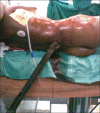Penetrating abdominal injury in a polytrauma patient: Anaesthetic challenges faced
- PMID: 21772699
- PMCID: PMC3127318
- DOI: 10.4103/0970-9185.81846
Penetrating abdominal injury in a polytrauma patient: Anaesthetic challenges faced
Abstract
Penetrating abdominal injuries are potentially life threatening due to the associated hemorrhagic shock and visceral injury. Through and through penetrating injury with polytrauma is rarely encountered. We report a case presenting with in situ projecting heavy metallic rod in a through and through penetrating abdominal injury along with foreign body in a road traffic accident. Anaesthetic management was difficult due to inability to position in supine, rapidly progressing hemorrhagic shock and hypoxia due hemopneumothorax. Two operating tables were used with adequate intervening space to accommodate the posteriorly projecting metallic rod during intubation in supine position. Intensive monitoring and resuscitation resulted in uneventful successful outcome.
Keywords: Operating table; penetrating abdominal injury; polytrauma; positioning; shock.
Conflict of interest statement
Figures




References
-
- Cavina E, Neidhart JP. The trauma of the abdomen: European course of trauma care. [Last accessed on 2010 Aug 12]. Available from: http://www.med.unipi.it/cdu/ECTC/indexectc.htm .
-
- Bowley DM, Robertson SJ, Boffard KD, Bhagawanjee S. Resuscitation and anaesthesia for penetrating trauma. Curr Opin Anaesthesiol. 2003;16:165–71. - PubMed
-
- Yong EL, Lim PH, Chng HC, Ng BK. Penetrating wounds of the abdomen and chest: An analysis of 107 consecutive cases. Singapore Med J. 1983;24:337–42. - PubMed
-
- Panchamia V, Thaker N, Jadeja C, Shah BJ. Emergency anaesthetic management of cardio thoracic and abdominal injury. Indian J Anaesth. 2007;51:131–3.
-
- Baraka AS, Sayyid SS, Assaf BA. Thiopental-rocuronium versus ketamine-rocuronium for rapid-sequence intubation in parturients undergoing cesarean section. Anesth Analg. 1997;84:1104–7. - PubMed

